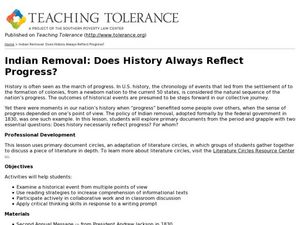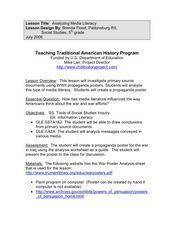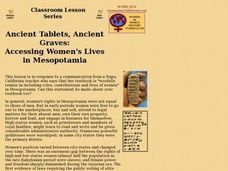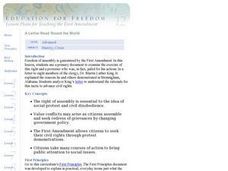Curated OER
The Real World Revisited
Class members participate in a series of hands on, online, and multimedia activities to identify the difference between primary and secondary sources. They watch a related video and visit a variety of sites to locate primary and...
Curated OER
Mapping My Spot in History
Students create their own town's history. They place themselves on the map in a literal as well as figurative sense. Students produce portions of an updated version of an early twentieth century panoramic map. Students gather information...
Curated OER
Real-Life History: Looking at Our Community
Spend several days with your class exploring local history. Learners brainstorm and categorize sources of historical information as primary or secondary; collect and present artifacts from family/community; construct a definition of...
Curated OER
Ancient Babylon
Authenticate an ancient civilizations study by having historians analyze primary source artifacts. After examining an image of a Babylonian king votive statue, pupils read a short background context. They then answer 3 questions based on...
Curated OER
Transparency Review
Students investigate and distinguish between primary and secondary sources when analyzing works of literature. They present their information on transparencies that are displayed to the class.
Curated OER
The Evolution of the Preamble
Reading and comprehending informational text is vital in all subject areas. Upper graders use primary sources and worksheets to better comprehend the historical importance of the Preamble of the US Constitution. Web links, handouts, and...
Curated OER
Using Primary Sources in the Classroom
Students draw their own conclusions by studying documents created in the past.
Curated OER
John Gary Evans and the Politics of Race
Students read letters written by Evans and Gunton regarding race relations. In this Progressive Movement lesson, students interpret the intentions and tone of the letters to understand contemporary racial beliefs. Students discuss the...
Curated OER
A Look at Virginians During Reconstruction
Fourth graders examine slavery and Reconstruction in Virginia. In this Virginians during Reconstruction instructional activity, 4th graders research primary sources for the story of William Jasper and other slaves. Students hypothesize...
Curated OER
Can You Hear Me Now?
Students explore the industry involving communication and put communication devices into activities. In this communication lesson plan, students put items into chronological order, review primary sources, compare and contrast items, and...
Curated OER
Learning From Document - Public Laws
Students research primary sources about the Bracero worker program. In this primary source instructional activity, students investigate two public laws along with other documents to determine if the Bracero worker program was implemented...
Curated OER
Lines From Behind the Lines
Fifth graders create a timeline of events in a soldiers life. In this World War I lesson, 5th graders learn about the Great Depression and World War I. Students watch video segments about World War I and examine primary sources from...
Curated OER
Indian Removal: Does History Always Reflect progress?
Young scholars explore the idea that progress for some might not mean progress for all. In this Native American lesson, students recognize different viewpoints about historical events through the study of primary documents. Young...
Curated OER
A Durable Memento: Portraits by Augustus Washington
Students read primary source newspaper articles from mid 19th century United States. The topics of the articles are slavery, abolitionism and colonization. Students are given several options for activities based on the readings.
Curated OER
Education, Design & Empowerment: Part One
Students consider the connection between poverty and education. In this language arts and social studies lesson plan, students research primary and secondary sources in order to explore the relationship between education and poverty.
Curated OER
Signature History
Students review the meaning and application of primary and secondary sources in research. They determine how researchers locate primary source documents before looking at signatures as a validating factor on many primary sources....
Curated OER
Death and Dying in Puritan New England: A Study Based on Early Gravestones, Vital Records, and other Primary Sources Relating to Cape Cod, Massachusetts
Students examine the time in which the Puritans lived in colonial New England. In groups, they research the Puritans view on life and death and discuss as a class. They read gravestones, diaries and other primary sources to discover...
Curated OER
Holes
Students distinguish between primary and secondary sources when researching on the Internet and evaluating historical records. They recognize important features of a primary source such as the type of document, who created it, what is...
Curated OER
The American Revolution: An Electronic Field Trip
Students examine basic facts of American Revolution, conduct Internet research to explore major events, choose topic and evaluate data, and write letters to or from fictitious person who could have been involved in that event during...
Curated OER
Analyzing Media Literacy
Fifth graders define propaganda, evaluate World War II propaganda posters to analyze media literacy, complete War Poster Analysis worksheet, and create and share their own propaganda posters containing subject matter pertaining to war in...
Curated OER
Family History
Fourth graders identify primary source items in the study of their families. They relate the importance of primary source materials in understanding history and events of the past.
Curated OER
Ancient Tablets, Ancient Graves: Accessing Women's Lives in Mesopotamia
High schoolers explore the role of women in ancient Mesopotamia. Several excerpts from the Mesopotamian cuneiform tablets and artifacts are analyzed to determine the treatment, rights, and powers of women in this era.
Curated OER
A Letter Read 'Round the World
Young scholars examine primary document to examine the concept of free assembly, and analyze Dr. Martin Luther King Jr's letter to the clergy to explain the rationale for this tactic to advance civil rights.
Curated OER
Trouble in the Fields: Mexican Migrant Workers
Students become curators and museum reviewers for an online gallery using a selected group of primary sources on Mexican migrant workers. They share and reflect on their own and each other's ideas though participation in an on-line...

























